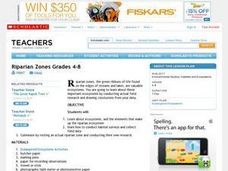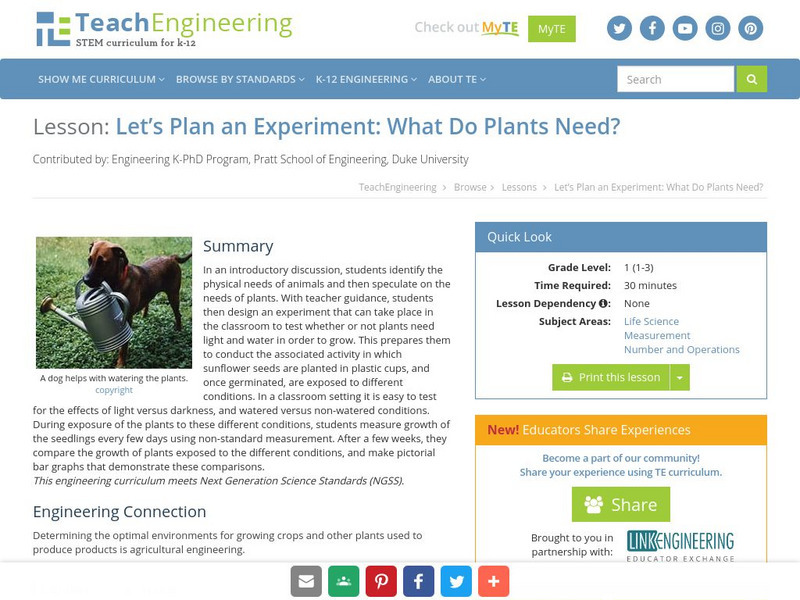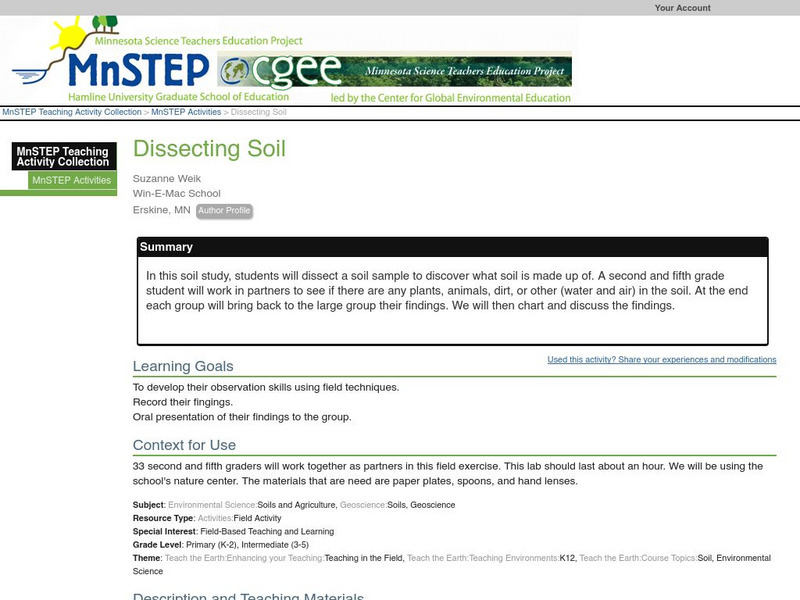Curated OER
John Muir: Long Ago and Now
Students explore nature objects brought indoors such as rocks, seeds, leaves and shells to identify where the objects came from. They hear stories about John Muir's life and make booklets about nature areas they enjoy.
Curated OER
The Mister Runtles' Bet
Students listen to a story dealing with exponential and linear growth. After reading the story, students complete a table comparing information. Using a calculator, students graph the rice and daily population of flies. They study the...
Curated OER
The Appearance of the Moon
Third graders watch a demonstration on how craters were formed on the moon. Individually, they care given a set of materials that represent the moon surface and make their own craters. To end the lesson, they measure the size of the...
Curated OER
Riparian Zones Grades 4-8
Students examine and analyze the Riparian Zones found on the edges of streams and lakes. They assess why those are such valuable ecosystems and then conduct actual field research on riparian zones and conclude by drawing conclusions from...
Curated OER
Summer Scientists
In this lesson, students discuss and reocrd what makes an object living or nonliving. The students then chart the lists of living and nonliving objects. Teacher allows students oportunity to go outside and look for living and ninliving...
Curated OER
Energy Defined
Fourth graders complete activities to study the sources of energy and forms. In this energy lesson, 4th graders discuss the origin of energy and define it. Students participate in several experiments to further study energy including a...
Curated OER
Introduction to Ecology
Eighth graders identify the living and nonliving components of an ecosystem. In this ecology instructional activity, 8th graders explain the role each organism plays. They participate in class discussion and answer a quiz at the end...
Curated OER
Love of Learning
Third graders discuss times when learning has been fun and when it hasn't. They imagine that the are going for a ride in an aeroplane. Students imagine that they are looking through the window at the land below, they see the uneven shape...
BioEd Online
Bio Ed Online: Living Things and Their Needs: We Need Water
This lesson focuses on living things' need for water. Students make lemonade and learn that water can be found in liquids other than a glass of water, and is also found in plants. The lesson can be downloaded in PDF format.
PBS
Pbs Learning Media: Animals and Plants Can Live in a City!
In this interactive lesson, students learn that animals need air, food, water, and shelter, while plants need air, sunlight, and water. Students watch videos and engage with drawing and sorting activities to reinforce their learning....
TeachEngineering
Teach Engineering: How Clean Is That Water?
This lesson plan helps learners understand the factors that affect water quality and the conditions that allow for different animals and plants to survive. Students will look at the effects of water quality on various water-related...
Alabama Learning Exchange
Alex: Race for Life: Plant Adaptations
This is an outdoors, hands-on activity. Create a short race course to engage young scholars in physical activity while drawing comparisons to the plant kingdom. This activity serves as an introductory to the impact small changes can have...
TeachEngineering
Teach Engineering: Who Needs What?
The teacher leads a discussion in which students identify the physical needs of animals, and then speculate on the needs of plants. With guidance from the teacher, the students then help design an experiment that can take place in the...
HotChalk
Hot Chalk: Lesson Plans Page: Ocean Unit Introduction
This lesson will introduce young students to oceans by looking at the animals, plants and water temperatures for different oceans.
Science Education Resource Center at Carleton College
Serc: Investigate Effects of an Oil Spill
This lab is designed so that students will understand the effects of oil spills on plants, animals, and the environment and investigate clean up methods through a simulated oil spill. They will understand the risks associated with...
Science Education Resource Center at Carleton College
Serc: Dissecting Soil
In this soil study, students investigate a soil sample to discover what is inside the soil. Working in partners, they explore to see if there are any plants, animals, dirt, or other (water and air) in the soil.














